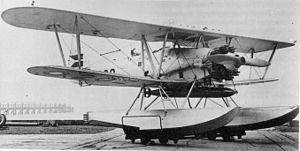
Summary
The Hawker Dantorp H.B. III was a Danish single-engined biplane bomber of the 1930s. The aircraft was a development of the British Hawker Horsley designed for the Danish Navy, but differed in being powered by a radial engine and having a third crew member. Two examples were built in Britain as a precursor to license production in Denmark. Financial constraints meant this was not realised and the Hawker-built examples were the only aircraft produced. They served until the German invasion of Denmark in 1940.
| Dantorp | |
|---|---|

| |
| The second Hawker Dantorp at Felixstowe, November 1932 | |
| Role | Torpedo bomber |
| Manufacturer | Hawker Aircraft |
| First flight | 19 September 1932 |
| Introduction | 1933 |
| Retired | 1940 |
| Primary user | Royal Danish Navy |
| Number built | 2 |
Design and development edit
The Hawker Dantorp was derived from the successful Hawker Horsley.[1] Originally designed to meet Air Ministry Specification 26/23 for a day bomber powered by a single Rolls-Royce Condor liquid-cooled engine, the Horsley entered service with the Royal Air Force in September 1927.[2]
One example of the Horsley, serial number J8620, was equipped with an Armstrong Siddeley Leopard 14-cylinder twin-row air-cooled radial engine.[3] The Leopard was the most powerful radial engine in the world at the time and in consequence promised much better performance.[4] Meanwhile, another Horsley, J8612, had been equipped with floats and demonstrated that the aircraft could be operated from the water.[5] The Danish Navy showed interest in these developments and, in 1930, ordered an aircraft type based on the design of the Horsley but equipped with the new engine and able to operate as a floatplane.[6] The aircraft was to be known as the Dantorp and was given the service number H.B.III.[7]
Description edit
The Dantorp was a large single-engined two-bay biplane of composite wood and metal construction. Unlike the two seat Horsley, it had a crew of three, with an additional crew position between the pilot and observer/gunner.[8] The aircraft mounted a forward-facing .303 in (7.7 mm) Vickers machine gun, a .303 in (7.7 mm) Lewis gun in a Scarff ring and could carry eight 50 kg (110 lb) bombs, two 551 kg (1,215 lb) bombs, one 1,500 lb (680 kg) bomb or a torpedo weighing 2,800 lb (1,300 kg).[9]
The aircraft was equipped to operate using interchangeable wheeled undercarriage and floats. The floats were designed as separate structures to allow for the carriage of a torpedo under the fuselage.[5]
Operational history edit
The first Dantorp, serial number 201, was first flown on 19 September 1932, equipped with a wheeled undercarriage.[8] The second, 202, followed shortly afterwards and was first tested with floats in November 1932. The aircraft were flown extensively in Denmark from 1933, but it took until 1935 for there to be good results from launching torpedoes.[7] They were also tested as catapult-launched floatplanes for operations off warships.[6] However, these trials did not lead to the adoption of the tactic by the Navy. The aircraft continued to be flown for the rest of the decade and both aircraft were operational when Germany invaded Denmark in 1940 although their subsequent history is unknown.[10]
The Danish Navy purchased a licence to build a further ten aircraft at the Danish Naval Workshops (Orlogsvaerftet), but a shortage of funds meant that the license was not taken up and no further aircraft were produced.[7]
Operators edit
- Marinens Flyvevæsen Two examples.[10]
Specification edit
Data from Hawker Aircraft since 1920[11]
General characteristics
- Crew: 3, pilot, navigator and bomb-aimer/gunner
- Length: 38 ft 4+1⁄2 in (11.697 m)
- Wingspan: 56 ft 5+3⁄4 in (17.215 m)
- Height: 14 ft 1 in (4.29 m)
- Wing area: 693 sq ft (64.4 m2)
- Empty weight: 5,360 lb (2,431 kg) (6,450 lb (2,930 kg) as a seaplane)
- Gross weight: 8,230 lb (3,733 kg) (9,420 lb (4,270 kg) as a seaplane)
- Fuel capacity: 230 imp gal (280 US gal; 1,000 L)
- Powerplant: 1 × Armstrong Siddeley Leopard IIIA air-cooled 14-cylinder twin-row radial engine, 805 hp (600 kW)
- Propellers: 2-bladed Watts wooden propeller
Performance
- Maximum speed: 126 mph (203 km/h, 109 kn) at 3,200 ft (980 m)
- Endurance: approx. 8.5 hr
- Service ceiling: 17,450 ft (5,320 m)
- Time to altitude: 12 min 50 s to 10,000 ft (3,000 m)
Armament
- Guns:
- 1 × forward-firing .303 in (7.7 mm) Vickers machine gun
- 1 × rear-mounted .303 in (7.7 mm) Lewis Gun
- Bombs: 1,500 lb (680 kg) bombload or 1 × torpedo
See also edit
Related development
Aircraft of comparable role, configuration, and era
Related lists
References edit
Citations edit
- ^ Mason 1994, p. 163.
- ^ Jarrett 1993, p. 25.
- ^ Mason 1991, pp. 138.
- ^ Smith 1981, p. 112.
- ^ a b Mason 1994, p. 164.
- ^ a b Mason 1991, p. 487.
- ^ a b c Balsved 2006.
- ^ a b Mason 1991, p. 139.
- ^ A Danish Correspondent 1934, p. 878.
- ^ a b Bridgman 1946, p. 11a.
- ^ Mason 1991, pp. 140–141.
Bibliography edit
- A Danish Correspondent (23 August 1934). "The Copenhagen Air Show". Flight. Vol. 26, no. 1339. pp. 878–880. Retrieved 6 September 2019.
- Balsved, Johnny E. (27 January 2006). "Naval Aviation (1912–): Danish Naval Air Service". Danish Naval History. Archived from the original on 27 February 2015. Retrieved 6 September 2019.
- Bridgman, Leonard (1946). Jane's All the World's Aircraft 1945. Newton Abbot: David & Charles. ISBN 978-0-7153-5019-5.
- Jarrett, Philip (October 1993). "By Day and By Night: Hawker Horsley part 1". Aeroplane Monthly. Vol. 21, no. 10. pp. 32–40.
- Mason, Francis K. (1991). Hawker Aircraft since 1920 (third ed.). London: Putnam. ISBN 978-0-8517-7839-6.
- Mason, Francis K. (1994). The British Bomber since 1914. London: Putnam. ISBN 978-0-8517-7861-7.
- Smith, Herschel (1981). Aircraft Piston Engines. New York: McGraw-Hill. ISBN 978-0-0705-8472-3.


